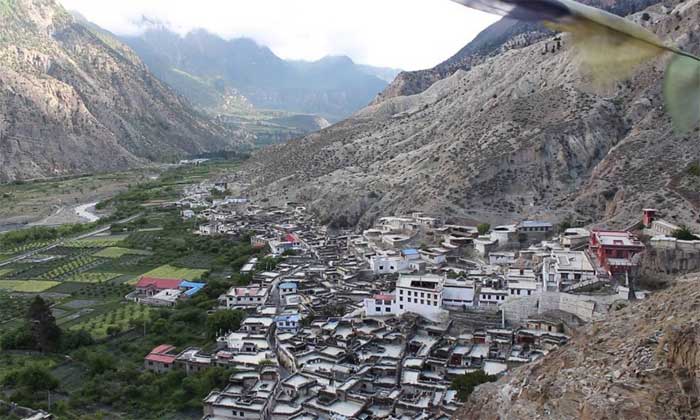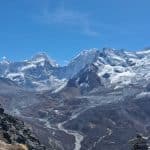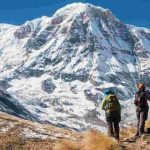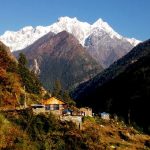Marpha

Marpha is a picturesque village in the Mustang district of Nepal. Located at an altitude of 2650m in the Kali Gandaki Valley of the lower Mustang region, the village is a tourist hub spot. Two words “mar” meaning hard-working, and “pha” meaning people combine to form the word Marpha.
Marpha is one of the rare places where heritage and modernity coexist beautifully. While the tourism boom has brought modern amenities to the village, the locals have worked enthusiastically to preserve their culture and heritage.
The livelihood of the people depends upon Tourism and mule rearing. The word “Marpha apple” is famous all over the country. Various brandy and jams use these apples as their main ingredient. You will get presented with strong brandy and sweet apple pie upon your arrival at Marpha.
The cobblestone alleyways and the flat roof houses add to the quaint atmosphere of the place. Read further for detailed information about Marpha and various things you should know before visiting the place.
How to Get to Marpha?
There are basically two ways to go to Marpha, one is by a domestic flight, and the other is by road. The flight from Pokhara to Jomsom takes about half an hour and then you will have to walk to Marpha, which takes another half an hour. You can also hire a jeep taxi.
If you are feeling adventurous, you can also try out the local jeeps and 4wds that move along the dusty, treacherous roads. Marpha lies along the trail of the famous Annapurna Circuit, and you stay overnight and acclimatize. If you trek to Marpha, it will take you at least four days to reach Marpha from Beni.
Where to stay? The accommodation
Marpha has seen a tourism boom as of late. So, you can find many lodges, guest houses, and even small hotels around the are offering great food and accommodation. There is some homestay available too that provides you with a unique lived-in experience of the place.
The facilities are basic with a room, bed and a fuzzy blanket. Some high-end stays do offer the luxury of a hot shower and wi-fi, but you will need to pay extra bucks. Overall, the accommodations are satisfactory and reasonable when you consider the cost.
Things to Do in Marpha
1. Visit the Horticulture Apple Farm
There is a Horticultural apple farm established in the year 1966 which helped the local community to get into organised apple production. These apples are famous all over the country, and the word “Marpha apple” is now synonymous with the best quality of apples.
2. Take a Tour of the Distillery
You can also tour a local distillery manufacturing apple brandy. There you can sample cider, or pluck some dried apples with permission. These apples are worth triple the price in the cities. There are distilleries work in the south of the village where there are lesser households.
3. Pay a Pilgrimage to the Monastery
The “Daily Puja” (worship) in The Nyingma monastery will calm you spiritually. The panoramic view of the Gandaki River valley from the monastery is a thing of beauty. The chili peppers and herbs left to dry in the afternoon sun makes for a fantastic view.
4. Explore the Cultural Museum
A unique museum dedicated to Japanese Zen monk Ekai Kawaguchi is another attraction of the place. The heritage museum has some of his possessions and details about his travels in Tibet. The museum plays a vital role in preserving arts and artifacts and also welcomes many religious devotees.
5. Visit the Marpha Foundation
The Marpha Foundation started by Jessica Kain has contributed a lot to the overall development of the education sector of the village. They hold an Artist in Residence program for Nepali artists. You can also visit the community center that has a library that promotes creative ways of learning.
6. Take A Side Trip To Marpha Hill
You can take a side trip to Marpha hill. There is an old Mamti cave towards the south. There are three gompas including a white and ochre painted gompa situated at the of the rocky wall in the north. The view of the entire village from the hilltop is spectacular.
Delicacies of Marpha
The local hotels provide various delicacies, including the local apple made products like apple pie, apple cider drink, pickles, and brandy. You can also get local cuisine like Thukpa, Tongba, and Marpha’s speciality “Thakali” meal.
The Thakali meal comprises of rice, pulses, lentils, vegetables, meat, achaar (pickles), and gundruk among others. Besides, these the famous “ghiu chiya” or butter tea and yak momos are also quite renowned in the region.
In case you are craving for western cuisine, you can find them in some of the fancy hotels. There you will get western delicacies like pizza, burgers, pasta, and a variety of bakery items.
The Architecture of the Place
The cherry wood-paneled doors and windows beautifully complement the white stone houses. Almost every home has a white and burgundy totem, a mural painted on the rock, and a rooftop stacked with wood. The chopped pieces of wood used in the bitterly cold winters are also a public display of the family’s wealth.
You can find a typical thakali styled flat-roofed houses in Marpha. These aesthetically pleasant flat roofs have a distinct purpose of drying vegetables, apples, and woods. The architecture of the houses is efficient, and there is a small courtyard inside that provides an excellent cover from the harsh afternoon winds.
Culture and Religion
Thakalis are the primary inhabitants of the place, and they are further divided into four clans. Just 20 minutes away from the new settlement you can find the old settlement. You can also find the famous “Falo Dhalo” (two dead juniper trees) in the old settlement of Marpha.
The smiling locals are very welcoming and provide incredible hospitality locals. They are eager to show their culture and traditions to foreigners. The streets of the main center are stone-paved along with the rest of the village catering to trekkers. The impact of Tibetan Buddhism is prominent and people here are deeply religious.
There are numerous chortens placed alongside the monastery and the village. According to popular beliefs, building chortens along with performing religious rituals at the site will avert illness, natural calamities and will prosper the entire village.
Best Time to Travel
You can visit Marpha at any time of the year. However, the autumn months of September to November and the spring months of March to May present the best trekking conditions.
The temperatures are moderate and clear, unobstructed views of the snow-capped mountains will enthrall you. The Tibetan new year of “losar” lies between February and March. During this time of the year, the place lively and is perfect for the exploration of Marpha.
Conclusion
You will not find a more picturesque village than Marpha in the entire country. The ancient culture and heritage are well preserved by the locals. If you haven’t visited Marpha yet then you are missing out a lot. So, make sure you visit this tranquil place next time you are on a trip to Nepal.
Our Top Offer
Why booking with us ?
- Fully Locally Owned Company
- Quality Of Service and Competitive price
- Highly Professional Staff
- Flexible and customization trip itinerary
- 100% Customer satisfaction
Need help?
Nepal: 00977-9841273869 whatsapp: 00977-984127386924 hour customer service




